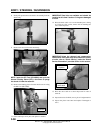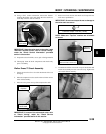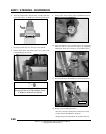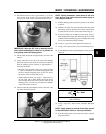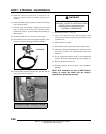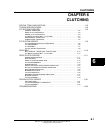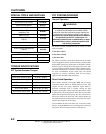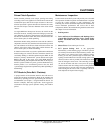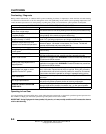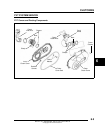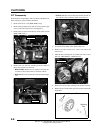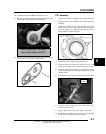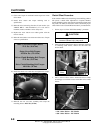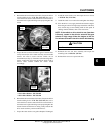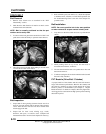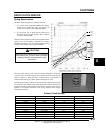
6.4
CLUTCHING
9923142 - 2011 RANGER RZR / RZR S / RZR 4 Service Manual
© Copyright 2010 Polaris Sales Inc.
Overheating / Diagnosis
During routine maintenance, or whenever PVT system overheating is evident, it’s important to check the inlet and outlet ducting
for obstructions. Obstructions to air flow through the ducts will significantly increase PVT system operating temperatures. The
vehicle should be operated in Low when plowing or pulling heavy loads, or if extended low speed operation is anticipated.
Operating in Low Gear
Low gear should be used when pulling heavy loads, riding through rough terrain, or when basic operational ground speeds are less
than 7 MPH. Use High gear when basic operational ground speeds are more than 7 MPH.
IMPORTANT: Using High gear for heavy loads, hilly terrain, or in wet, muddy conditions will increase the chance
of drive belt burning.
CLUTCH DRIVE BELT & COVER RELATED ISSUES: DIAGNOSIS
Possible Causes Solutions / What to do
Loading the vehicle into a truck or tall
trailer when in high range.
Shift transmission to Low during loading of the vehicle to prevent belt burning.
Starting out going up a steep incline from
a stopped position.
When starting out on an incline, use Low gear. Shift transmission to Low
during loading of the vehicle to prevent belt burning.
Driving at low RPM or low ground speed
(at approximately 3-7 MPH).
Drive at higher speed or use Low. The use of Low is highly recommended for
cooler PVT operating temperatures and longer component life.
Insufficient engine warm-up when
exposed to low ambient temperatures.
Warm engine at least 5 min., then with transmission in neutral, advance
throttle to approx. 1/8 throttle in short bursts, 5 to 7 times. The belt will
become more flexible and prevent belt burning.
Slow and easy clutch engagement. Fast, effective use of the throttle for efficient engagement.
Towing/Pushing at low RPM or low
ground speed.
Use Low only.
Plowing snow, dirt, etc./utility use. Use Low only.
Stuck in mud or snow.
Shift the transmission to Low, carefully use fast, aggressive throttle
application to engage clutch. WARNING: Excessive throttle may cause loss
of control and vehicle overturn.
Climbing over large objects from a
stopped position.
Shift the transmission to Low, carefully use fast, aggressive, brief throttle
application to engage clutch. WARNING: Excessive throttle may cause loss
of control and vehicle overturn.
Belt slippage from water or snow
ingestion into the PVT system.
Shift the transmission to neutral. Using the throttle, vary the engine rpm from
idle to full throttle. Repeat several times as required. During this procedure,
the throttle should not be held at the full position for more than 10 seconds.
Clutch seals should be inspected for damage if repeated leaking occurs.
Clutch malfunction.
Clutch component inspection should be performed by a Polaris MSD certified
technician.
Poor engine performance.
Fouled spark plugs, foreign material in fuel tank, restricted fuel lines, or faulty
fuel pump may cause symptoms similar to clutching malfunction.
GENERAL RANGE OPERATION
GUIDELINES:
Low: Heavy pulling, basic operational speeds less than 7 MPH, riding
through rough terrain (swamps, mountains, ect.), or low ground speeds.
High: High ground speeds, or speeds above 7 MPH.



